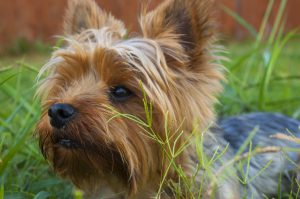 You could be putting your dog at risk, unknowingly, at the very place they are supposed to be the safest. In your home and in your yard.
You could be putting your dog at risk, unknowingly, at the very place they are supposed to be the safest. In your home and in your yard.
You need to take extra precautions in choosing houseplants and yard plants if you have a dog. Usually pet owners don’t know which plants are dangerous and potentially deadly to their dogs until it is too late.
I am going to provide you with a list of poisonous plants for dogs and of common plants many of us have in or around our homes, that could cause problems for your dog.
This list is not an all-inclusive list, but rather a compilation of the most frequently encountered plants. I feel that many of us currently have a lot of these plants in or outside our homes and aren’t aware of their potential danger for our dogs. I know many of them surprised me when I started researching them.
Table of Contents
Toxic House Plants
Dieffenbachia – One of the most common and easiest to grow houseplants.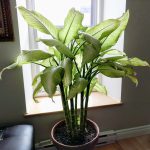 It can cause oral irritation, vomiting and difficulty swallowing. Your dog can also experience a burning sensation on the lips, tongue and mouth. Moderate to highly toxic.
It can cause oral irritation, vomiting and difficulty swallowing. Your dog can also experience a burning sensation on the lips, tongue and mouth. Moderate to highly toxic.
Po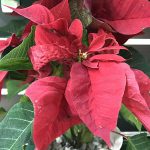 insettia – Generally around only at Christmas, but the leaves, stem and flower are highly toxic.
insettia – Generally around only at Christmas, but the leaves, stem and flower are highly toxic.
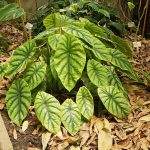 Alocasia – There are 79 different species of this plant. Leaves, stems and roots are all poisonous. It can cause mucous membrane irritation, intense burning and irritation of the mouth, lips and tongue, excessive drooling, vomiting and difficulty in swallowing.
Alocasia – There are 79 different species of this plant. Leaves, stems and roots are all poisonous. It can cause mucous membrane irritation, intense burning and irritation of the mouth, lips and tongue, excessive drooling, vomiting and difficulty in swallowing.
 Calla Lily – Signs are visible almost immediately in your dog if they have ingested this plant. All parts of the plant are toxic. Symptoms include oral pain, diarrhea, drooling, lack of appetite, and pawing at the mouth.
Calla Lily – Signs are visible almost immediately in your dog if they have ingested this plant. All parts of the plant are toxic. Symptoms include oral pain, diarrhea, drooling, lack of appetite, and pawing at the mouth.
Toxic Perennial
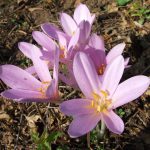 Autumn Crocus – Can cause an intense burning sensation in the mouth, vomiting, diarrhea, seizures, liver and kidney damage, and even heart arrhythmias. The entire plant is considered toxic to dogs, but the toxicity is highest in the bulbs of the plant.
Autumn Crocus – Can cause an intense burning sensation in the mouth, vomiting, diarrhea, seizures, liver and kidney damage, and even heart arrhythmias. The entire plant is considered toxic to dogs, but the toxicity is highest in the bulbs of the plant.
 Daffodil – The entire plant is considered poisonous to dogs, but the bulb is the most toxic. Ingesting any portion of a Daffodil can cause vomiting, diarrhea, abdominal pain, arrhythmias, convulsions and serious drop in blood pressure.
Daffodil – The entire plant is considered poisonous to dogs, but the bulb is the most toxic. Ingesting any portion of a Daffodil can cause vomiting, diarrhea, abdominal pain, arrhythmias, convulsions and serious drop in blood pressure.
 Tulip – Once again, the entire plant of a tulip is considered toxic, but it is the bulb that is the most poisonous to dogs. Ingestion can cause significant oral irritation, excessive drooling and nausea.
Tulip – Once again, the entire plant of a tulip is considered toxic, but it is the bulb that is the most poisonous to dogs. Ingestion can cause significant oral irritation, excessive drooling and nausea.
 Begonias – Can cause vomiting, bloody diarrhea, muscle tremors, fatal heart abnormalities. Very toxic.
Begonias – Can cause vomiting, bloody diarrhea, muscle tremors, fatal heart abnormalities. Very toxic.
 Amaryllis – Popular around Easter. Its toxins can cause vomiting, depression, diarrhea, abdominal pain, hyper salivation, anorexia and tremors.
Amaryllis – Popular around Easter. Its toxins can cause vomiting, depression, diarrhea, abdominal pain, hyper salivation, anorexia and tremors.
 Foxglove – I have this listed with perennials, but it actually is a biennial. It has a two-year life span. The leaves are highly toxic.
Foxglove – I have this listed with perennials, but it actually is a biennial. It has a two-year life span. The leaves are highly toxic.
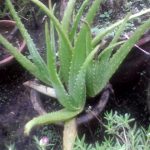 Aloe Vera – While this has positive healing for humans, This plant will irritate the digestive system of your dog if ingested. It is not toxic to dogs if not ingested.
Aloe Vera – While this has positive healing for humans, This plant will irritate the digestive system of your dog if ingested. It is not toxic to dogs if not ingested.
Bulbs in general – Hyacinth, Narcissus, Daffodil are all very toxic to your dog. Tulip bulbs are mildly toxic.
Toxic Shrubs
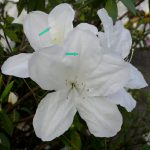 Azalea – The entire plant is considered toxic. Ingestion of just a few leaves can cause oral irritation with subsequent vomiting and diarrhea in dogs. Severe cases can cause a drop in blood pressure, coma and even death.
Azalea – The entire plant is considered toxic. Ingestion of just a few leaves can cause oral irritation with subsequent vomiting and diarrhea in dogs. Severe cases can cause a drop in blood pressure, coma and even death.
 Sago Palm – Extremely poisonous plant to dogs if they ingest it. The entire plant is poisonous. Causes bloody vomiting and diarrhea, bleeding disorders, liver failure and death.
Sago Palm – Extremely poisonous plant to dogs if they ingest it. The entire plant is poisonous. Causes bloody vomiting and diarrhea, bleeding disorders, liver failure and death.
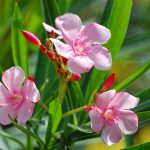 Oleander – Popular ornamental flowering shrub. Can cause fatal heart abnormalities, muscle tremors, vomiting and bloody diarrhea. Highly toxic.
Oleander – Popular ornamental flowering shrub. Can cause fatal heart abnormalities, muscle tremors, vomiting and bloody diarrhea. Highly toxic.
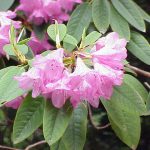 Rhododendron – All parts of the shrub are considered moderately to extremely toxic. Can cause oral irritations, vomiting and diarrhea with severe cases causing a drop in blood pressure, coma and death.
Rhododendron – All parts of the shrub are considered moderately to extremely toxic. Can cause oral irritations, vomiting and diarrhea with severe cases causing a drop in blood pressure, coma and death.
What To Do If You Believe Your Dog Ingested a Toxic Plant
It is vital to your dog’s outcome to act quickly and appropriately if your dog is poisoned.
- Evaluate the Situation – Identify what toxin your dog has ingested. Evaluate your dog’s symptoms.
- Call the Pet Poison Helpline – 1-855-213-6680, your local veterinarian or the APC 24-hour emergency poison hot line at 1-888-426-4435. They can determine if the exposure is considered toxic, and if additional treatment is necessary. It is common to have to induce vomiting.
- Do not give your dog any home remedies. Try to stay calm and don’t give your dog anything unless instructed by a veterinarian.
- Get Help – If further treatment is required, transport your dog to your veterinarian or Animal Hospital immediately.
Better Safe Than Sorry
There are actually over 700 plants that are toxic to dogs, the above list of poisonous plants for dogs are some of the more common plants that you might already have. For a complete list visit either ASPCA or the Humane Society.
Puppies are at a larger risk of getting into plants when they shouldn’t. They are more likely to chew on everything they find while they are exploring, especially when their teeth are changing to adult teeth. They are also more likely to dig up plants, making it more likely that they could potential get access to a bulb and eat it.
Plan ahead. If you are putting in new flowers or shrubs and you have a dog or might be getting one in the future, make sure what you are planting is safe for your dog. Take a walk around your yard and see if you currently have any potentially dangerous plants already and either replace, or make sure that it is in an area that you keep your dog away from.
Look over the list of plants that are dangerous, so if the worst happens and your dog does eat a dangerous plant, you will know which plant is dangerous so you can get that information to your veterinarian quickly and know how to handle the situation. If the worst happens, have your information ready ahead of time. When you are in a panic about your dog, you won’t think as clearly and could waste valuable time trying to figure out the situation.
Please leave any questions or comments below. I am happy to hear what you think and help any way that I can. You can follow justforyourdog.com on Pinterest, FaceBook or Twitter for all the latest dog updates.
Some of the links within this post are affiliate links of which I might receive a small compensation from sales of certain items.

Thanks for the informative post! I was not aware of all these common plants that pose a health risk to my dogs! I will definitely take this information to heart when selecting plants.
Thank you for your comments. Please take extra care if you have puppies. They are at the greatest risk since they dig more and chew on everything they can find.